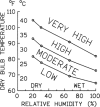National Athletic Trainers' Association Position Statement: Exertional Heat Illnesses
- PMID: 12937591
- PMCID: PMC164365
National Athletic Trainers' Association Position Statement: Exertional Heat Illnesses
Abstract
OBJECTIVE: To present recommendations for the prevention, recognition, and treatment of exertional heat illnesses and to describe the relevant physiology of thermoregulation. BACKGROUND: Certified athletic trainers evaluate and treat heat-related injuries during athletic activity in "safe" and high-risk environments. While the recognition of heat illness has improved, the subtle signs and symptoms associated with heat illness are often overlooked, resulting in more serious problems for affected athletes. The recommendations presented here provide athletic trainers and allied health providers with an integrated scientific and practical approach to the prevention, recognition, and treatment of heat illnesses. These recommendations can be modified based on the environmental conditions of the site, the specific sport, and individual considerations to maximize safety and performance. RECOMMENDATIONS: Certified athletic trainers and other allied health providers should use these recommendations to establish on-site emergency plans for their venues and athletes. The primary goal of athlete safety is addressed through the prevention and recognition of heat-related illnesses and a well-developed plan to evaluate and treat affected athletes. Even with a heat-illness prevention plan that includes medical screening, acclimatization, conditioning, environmental monitoring, and suitable practice adjustments, heat illness can and does occur. Athletic trainers and other allied health providers must be prepared to respond in an expedient manner to alleviate symptoms and minimize morbidity and mortality.
Figures


References
-
- Hawley D A, Slentz K, Clark M A, Pless J E, Waller B F. Athletic fatalities. Am J Forensic Med Pathol. 1990;11:124–129. - PubMed
-
- Mueller F O, Schindler R D. Annual survey of football injury research 1931–1984. Athl Train J Natl Athl Train Assoc. 1985;20:213–218.
-
- Bijur P E, Trumble A, Harel Y, Overpeck M D, Jones D, Scheidt P C. Sports and recreation injuries in US children and adolescents. Arch Pediatr Adolesc Med. 1995;149:1009–1016. - PubMed
-
- Tucker A M. Common soccer injuries: diagnosis, treatment and rehabilitation. Sports Med. 1997;23:21–32. - PubMed
-
- Martin D E. Influence of elevated climatic heat stress on athletic competition in Atlanta, 1996. New Stud Athl. 1997;12:65–78.
LinkOut - more resources
Full Text Sources
Other Literature Sources
